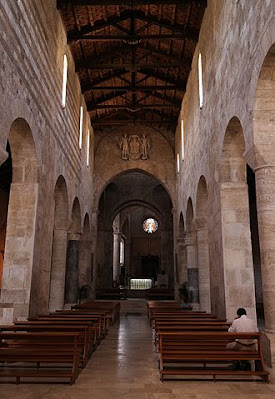Basilicas in Italy—Aburzzo—2
Cathedral Basilica of St. Bernard and the Assumption of Mary, Teramo, Teramo
Declared a minor basilica by Pope Pius XII in 1955.
The basilica is the cathedral for the Diocese of Teramo-Atri. It was built in a Romanesque style between 1158 and 1174 using stone from former Roman buildings. It replaced a cathedral that had been destroyed in a fire. A renovation in the 1330s added Gothic elements to the basilica. Renovations in the 18th Century added Baroque elements. The church has a 15th Century silver altarpiece.
All pictures are from Wikipedia.
Basilica of Our Lady of the Seven Sorrows, Pescara, Pescara
Declared a minor basilica by Pope John XXIII in 1959.
A statue of the Madonna pierced with the Seven Sorrows was found by shepherds in the early 17th Century. A small chapel was erected and was replaced with the current church. This church was built in a neoclassical style between the late 18th Century and the early 19th Century.
The top two pictures are from local sources and the bottom picture is from Wikipedia.
Co-Cathedral Basilica of the Assumption of Mary, Atri, Teramo
Declared a minor basilica by Pope Paul VI in 1964.
The basilica is the co-cathedral for the Diocese of Teramo-Atri. It was built in the 13th Century to replace an earlier church, and it employs both Romanesque and Gothic styles. It was built on the site of a Roman bath, and some ruins are still present within the church. The church has several frescoes and other works of art.
All pictures are from Wikipedia.
Basilica of Our Lady of the Hill, Pescocostanzo, L’Aquila
Declared a minor basilica by Pope Paul VI in 1976.
The church was built in the 15th Century and enlarged in the 16th Century. It has a Renaissance exterior and a Baroque interior.
All pictures are from Wikipedia.
Basilica of the Holy Face, Manoppello, Pescara
Declared a minor basilica by Pope Benedict XVI in 2006.
This church was completed in 1620 in a Renaissance style. It was built to house the veil of Veronica—the Holy Face of Jesus. The veil has been in Manoppello since 1506. It needs to be noted that there are several places in Europe that claim to have the veil.
The first picture is from Pinterest and the others are from local sources.
Basilica Shrine of Our Lady of Miracles, Casalbordino-Miracoli, Chieti
Declared a minor basilica by Pope Benedict XVI in 2010.
Our Blessed Mother appeared to a shepherd in 1576. Miracles were attributed to prayers said at this site and pilgrims soon started to come. A church was built in the 16th Century. A larger church was built in the early 19th Century and was enlarged and repaired following the First World War. Allied bombing damaged the church during the Second World War and the renovations were once again required. The current Neo-Renaissance church was completed in 1962.
The first picture is from TripAdvisor and the other two are from local sources.
Basilica of St. Joseph the Worker, L’Aquila, L’Aquila
Declared a minor basilica by Pope Francis in 2013.
The church was originally built in the mid-13th Century and was dedicated to St. Biagio. It was built next to the Cathedral but was heavily damaged by an earthquake in 1703. Attempts were made to rebuild the church, but it was abandoned in the late 18th Century. It wasn’t until the late 20th Century that the church was renovated (Baroque and Neoclassical) and reopened under its current name. Both this church and the Cathedral were heavily damaged by a 2009 earthquake. This church was able to reopen by 2012, but restoration work on the Cathedral continues. In the meantime, the Basilica serves as the pro-Cathedral for the Archdiocese.
All pictures are from Wikipedia.
Co-Cathedral Basilica of St. Mary of Grace, Pescina, L’Aquila
Declared a minor basilica by Pope Francis in 2016.
The basilica is the co-cathedral of the Diocese of Avezzano. The Renaissance church was built in the late 16th Century. It was badly damaged by an earthquake in 1915 and rebuilt by 1930 only to be bombed during the Second World War. It was restored again and reconsecrated in 1961.
The pictures are from local sources and Wikipedia.































No comments:
Post a Comment